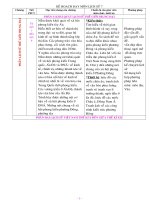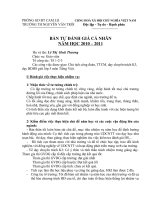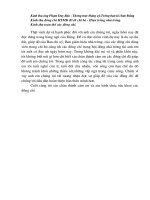Bài giảng Odor perception (Cảm nhận mùi) ĐHBK TPHCM
Bạn đang xem bản rút gọn của tài liệu. Xem và tải ngay bản đầy đủ của tài liệu tại đây (3.71 MB, 17 trang )
Odor Perception
• Overview
➜ Olfaction: a "bad" Sense?
➜ The Olfactory System
ODOR PERCEPTION
➜ The Nature of Smell
➜ Odor and Behavior
Claire Sulmont-Rossé
➜ General Conclusion
Claire Sulmont-Rossé
Updated April 10, 2008
Olfaction: a "bad" Sense?
Olfaction: a "bad" Sense?
• Some philosophical points of view
• Some philosophical points of view
➜ Olfaction is associated with sex
➜ Olfaction is associated with animality
Freud: since humans walks upright, they
can "see" what is happening around
them. As many odors are heavier than
air, smelling implies lying on the ground,
like animals.
Antiquity: perfumes are associated with
physical pleasure and prostitution.
Plato, Kent, Freud: olfaction is a sense of
lust, desire and impulse. Its carries the
sense of animality.
Humans are unable to express odors in
language,
a
capacity
which
is
quintessentially human and testifies to
civilization.
Claire Sulmont-Rossé
Updated April 10, 2008
Claire Sulmont-Rossé
Updated April 10, 2008
Olfaction: a "bad" Sense?
Olfaction: a "bad" Sense?
• Some performance data
• Some performance data
➜ Sensitivity
Dogs are from 300 to 10,000 times more
sensitive to odors than humans.
➜ Discrimination ability
Humans could distinguish thousands of
different types of odorants.
➜ Identification ability
When asked to identify familiar odors,
people were successful only about half the
time.
Claire Sulmont-Rossé
Updated April 10, 2008
➜ Macrosmates (good smellers)
Many mammals (rodents, herbivores, many
predators), fishes, amphibians, reptiles,
insects
➜ Microsmates (poor smellers)
Birds, Humans
➜ Anosmates (non-smellers)
Whale
Claire Sulmont-Rossé
Updated April 10, 2008
Olfaction: a "bad" Sense?
Olfaction: a "bad" Sense?
• odorants
• Olfaction: a "bad" sense?
➜ Chemical compounds
➜ Protection against harmful subtances
not every chemical is odorant
Olfaction allows us to detect rotten food,
leaking gas…
➜ In order to be smelled:
➜ Attraction to edible substances
molecule must be
Olfaction allows us to enjoy our meals.
volatile, small, and hydrophobic
➜ Chemical communication
Olfaction might influence physiology and
behavior of conspecific.
Claire Sulmont-Rossé
Updated April 10, 2008
Claire Sulmont-Rossé
Olfaction: a "bad" Sense?
Odor Perception
• Olfaction: a "bad" sense?
• Overview
« Sense of smell? I never gave it a thought. You
don't normaly give it a thought. But when I lost it –
it was like being struck blind. Life lost a good deal
of its savour – one doesn't realise how much
"savour" is smell. You smell people, you smell
books, you smell the city, you smell the spring –
maybe not consciously, but as a rich unconscious
background to everything else. My whole world was
suddenly radically poorer… »
Updated April 10, 2008
➜ Olfaction: a "bad" Sense?
➜ The Olfactory System
➜ The Nature of Smell
➜ Odor and Behavior
➜ General Conclusion
The Man who Mistook his Wife for a Hat, Sacks, 1985
Claire Sulmont-Rossé
Updated April 10, 2008
Olfactory Physiology (cont’d)
Claire Sulmont-Rossé
Updated April 10, 2008
The Nose
• The human olfactory apparatus:
➜ Primary purpose of nose:
to filter, warm, humidify air we breathe
➜ Nose:
Small ridges,
epithelium
Claire Sulmont-Rossé
olfactory
cleft,
olfactory
Updated April 10, 2008
Claire Sulmont-Rossé
Updated April 10, 2008
The Olfactory System
The Olfactory System
• Location
• Odor pathways
➜ Orthonasal
• Odor pathways
Olfactory
mucosa
Nasal cavity
➜ Through the retronasal pathway, olfaction
has a strong influence on perception and
appreciation of food
Nostril
pathway
Septum
« There is a good reason not to talk
with one's mouth full: it means a
loss of precious smells making
their way to the organ of olfaction. »
➜ Retronasal
pathway
Tongue
Smell, the Secret Seducer, Vroon, 1994
Oral cavity
Claire Sulmont-Rossé
Updated April 10, 2008
The Olfactory System
• Odor pathways
% subjects identifying each food:
- with nostril open (blue bars)
- nostrils pinched shut (red bars)
Claire Sulmont-Rossé
Updated April 10, 2008
The Olfactory System
• Odor pathways
Chocolate
➜ Odors
perceived via the retronasal
pathway could be different from odors
perceived via the orthonasal pathway
Grape juice
Cinnamon
Pineapple
Mozell et al., 1969
Difference in concentration
Action of chewing and saliva
Onion
Lemon
Wine
Coffee
0
20
40
60
80
100
Percentage of subjects
Claire Sulmont-Rossé
Updated April 10, 2008
Claire Sulmont-Rossé
Updated April 10, 2008
The Olfactory System
The Olfactory System
• Vocabulary conventions
• The olfactory organ
➜ Odor
Brain
Perceived through the orthonasal pathway
➜ Aroma
Olfactory tract
Olfactory bulb
Perceived through the retronasal pathway
➜ Taste
Perceived by the tongue (gustation)
Mitral cell
Cribiform
ethmoid bone
Glomerulus
Axons
Supporting layer
➜ Flavor
Olfactory
mucosa
Aroma + taste of a food
Olfactory
cortex
Olfactory
epithelium
Olfactory cell
Mucous layer
Nasal cavity
Claire Sulmont-Rossé
Updated April 10, 2008
Claire Sulmont-Rossé
Updated April 10, 2008
The Olfactory System
The Olfactory System
• The mucous layer
• location & structure
➜ Odorant Binding Protein (OBP)
Transportation of the lipophilic odorants
across the hydrophilic mucous
Protection of the olfactory
preventing an oversaturation
cells
Brain
by
Transportation of the odorants across the
membrane of the olfactory cells ???
Olfactory cell
Dendrite
Support cell
Removal of the odorants from the olfactory
cells ???
Claire Sulmont-Rossé
Axons
Basal cell
Updated April 10, 2008
Olfactory Physiology (cont’d)
Cilias
Mucous
Nasal cavity
Claire Sulmont-Rossé
Updated April 10, 2008
Olfactory Sensory Neuron
• olfactory epithelium “retina of the nose”:
➜ types of cells:
1. Supporting cells
2. Basal cells
3. Olfactory sensory neurons (OSNs)—cilia
protruding into mucus covering olfactory
epithelium
Olfactory receptors (ORs):
on tips
Interaction between these and odorant
stimulates cascade of biochemical events
Claire Sulmont-Rossé
Updated April 10, 2008
Claire Sulmont-Rossé
Updated April 10, 2008
Updated April 10, 2008
Claire Sulmont-Rossé
Updated April 10, 2008
Olfactory Perception
Pathway
Claire Sulmont-Rossé
The Olfactory System
The Olfactory System
• olfactory receptor cells
• The olfactory cell
➜ Olfactory receptor
➜ Statistics
30,000 cells per mm2
Brain
20 million cells
➜ Peculiar facts
The olfactory cell is a neuron in direct
contact with inhaled substances.
The olfactory cell is replaced after 4 to 8
weeks by a new neuron (neurogenesis).
Claire Sulmont-Rossé
Updated April 10, 2008
Nasa lcavity
Claire Sulmont-Rossé
Updated April 10, 2008
The Olfactory System
The Olfactory System
• The olfactory cell
• The olfactory cell
➜ Mechanism of transduction
Odor
➜ Receptor specificity
++
Ca
Odor
receptor
+
The number of discriminable odorants is far
larger than the number of receptors.
Ca++
Na+
NH2
Na+
cAMP-dependant
cation channel
Some odorants are perceived as having
different odors at different concentration.
Odor
-
Adenylyl
cyclase
Protein
G
COOH
Na+
cAMP
A receptor recognizes several odorants
and an odorant is recognized by several receptors
Ca++
Ca++
Na+
ATP
Claire Sulmont-Rossé
Updated April 10, 2008
Claire Sulmont-Rossé
Updated April 10, 2008
The Olfactory System
The Olfactory System
• The olfactory cell
• The olfactory cell
➜ Receptor specificity: Sicard & Holley, 1984
ANI
ACE
PHO
PYR
PHE
IVA
MEN
THY
CIN
CAM
CDN
HEP
BUT
MAC
ISO
XON
XOL
DCI
LIM
CYM
Claire Sulmont-Rossé
➜ Odor coding
Different odorants are recognized
different combination of receptors.
3 4 5 52 5 4 1 4 1 1 3
1 1 5 5 4 2 3 3 4 2 4 1 4 6 5 3 3 3 4 4 2 2 2 3 5 2 3 1 2 5 5 11 3 5 2 2 4 1
6 1 1 2 5 7 8 3 9 7 0 9 2 6 7 8 7 2 5 6 1 5 5 3 8 3 4 4 8 1 0 9 9 6 5 7 4 6 3 2 1 5 0 8 6 2 0 9 7 0 2 43 4 4 0 9 8 3 1
by
Each olfactory cell expresses only one type
of receptor.
Odor quality is coded by the combination
of fired olfactory cells
Updated April 10, 2008
Claire Sulmont-Rossé
Updated April 10, 2008
Olfactory Physiology (cont’d)
The Olfactory System
• genetics of olfactory receptors:
• The olfactory bulb
➜ Location & structure
➜ Buck and Axel (91)
human genome contains about 1000
different olfactory receptor genes, each
codes for single type of OR
Granule cell
➜ Pseudogenes – 60-70% in humans
Mitral or tufted cell
➜ Trade-off between vision and olfaction
Peri-glomerular cell
Glomerulus
Olfactory cell axon
Claire Sulmont-Rossé
Updated April 10, 2008
Claire Sulmont-Rossé
Updated April 10, 2008
The Olfactory System
• The olfactory bulb
• All neurons expressing a particular OR
type converge onto one glomerulus pair
in the olfactory bulb
➜ Glomerulus specificity
Pattern of labeling of a 35S-labeled
receptor gene M50 probe in a mouse
olfactory bulb: the axons of the
olfactory cell that express the
receptor gene M50 converge on the
same glomerulus.
➜ No matter where they are on the nasal
epithelium
➜ However, each glomerulus pair receives
axons from several different receptor
types
Ressler et al., 1994
Claire Sulmont-Rossé
Updated April 10, 2008
Claire Sulmont-Rossé
Updated April 10, 2008
The Olfactory System
The Olfactory System
• The olfactory bulb
• The olfactory bulb
➜ Odor coding
➜ Odor coding
Different odorants fire different combination
of olfactory cells.
Each glomerulus receives input from the
olfactory cells that express the same
receptor.
Pattern of labeling of a 35Slabeled c-fos probe in a rat
olfactory bulb exposed to
peppermint: a single odorant
stimulates multiple glomeruli.
Guthrie et al., 1993
Odor quality is coded by the combination
of fired glomeruli
Claire Sulmont-Rossé
Updated April 10, 2008
Claire Sulmont-Rossé
Updated April 10, 2008
The Olfactory System
The Olfactory System
• The olfactory cortex
• The olfactory cortex
Olfactory bulb
Anterior commissure
Anterior olfactory nucleus
& olfactory tubercle
Thalamus
Olfactory
tubercle
Pyriform
cortex
Amygdala
Entorhinal
cortex
Hypothalamus
Orbitofrontal cortex
Thalamus
Amygdala
Olfactory tract
Olfactory bulb
Frontal cortex
Hypothalamus
Orbitofrontal
cortex
Toward the
entorhinal cortex
Pyriform cortex
Claire Sulmont-Rossé
Updated April 10, 2008
AssociationEmotion
?
Perception & discrimination
Claire Sulmont-Rossé
Odor Perception
• Conclusion
• Overview
with stimuli.
➜ Olfactory information does not relay in the
thalamus before reaching the cortex.
➜ Olfactory process is slow (seconds rather
Memorisation ?
Updated April 10, 2008
The Olfactory System
➜ Sensory cells are neurons in direct contact
Hippocampus
➜ Olfaction: a "bad" Sense?
➜ The Olfactory System
➜ The Nature of Smell
➜ Odor and Behavior
➜ General Conclusion
than milliseconds).
From an evolutionary point of view,
the olfactory system is an "old" system
Claire Sulmont-Rossé
Updated April 10, 2008
Claire Sulmont-Rossé
Updated April 10, 2008
The Nature of Smell
The Nature of Smell
• What factors determine the olfactory
quality of a molecule?
• Ascending approach
Ascending approach
Odorous molecule
➜ Molecules
with different physical and
chemical properties elicit different odor
sensations
Key-lock model
Odor perception
Descending approach
Claire Sulmont-Rossé
Updated April 10, 2008
Claire Sulmont-Rossé
Updated April 10, 2008
From Chemicals to Smells
Presumed Odorant-Receptor Binding
• Theories of olfactory perception:
➜ Shape-pattern theory:
Match between shapes of odorants and odor
receptors; dominant biochemical theory
➜ Molecular research:
Scents detected by means of combinatorial codes
➜ Vibration theory:
different vibrational frequency for every perceived
smell, molecules that produce same vibrational
frequencies will produce same smell
Claire Sulmont-Rossé
Updated April 10, 2008
Claire Sulmont-Rossé
Updated April 10, 2008
The Nature of Smell
From Chemicals to Smells (cont’d)
• Ascending approach
• Specific anosmia:
➜ Theory of Amoore, 1970
➜ inability to smell one specific compound
with otherwise normal smell perception
Existence of specific anosmia
➜ 50% of population has specific anosmia
to androstenone
➜ repeated exposure can sometimes enable
detection
➜ not consistent with vibration theory
Claire Sulmont-Rossé
Updated April 10, 2008
Claire Sulmont-Rossé
Updated April 10, 2008
The Nature of Smell
The Nature of Smell
• Ascending approach
• Ascending approach
➜ Theory of Amoore, 1970
Concept of primary odors
PRIMARY ODORANT
PRIMARY ODOR
ANOSMIC OCCURRENCE
Isovaleric acid
Sweaty
1-Pyrroline
Spermous
Trimethylamine
Fishy
6%
Isobutyraldehyde
Malty
36%
5α-Androst-16-en-3-one
Urinous
47%
ω-Pentadecalactone
Musky
12%
l-Carvone
Minty
1,8-Cineole
Camphorous
Claire Sulmont-Rossé
3%
16%
➜ Theory of Amoore, 1970
Determination of the physical and chemical
properties which elicit each primary odor
sensation
Trimethylamine
1,8-cineole
ω-pentadecalactone
Isovaleric acid
8%
33%
Updated April 10, 2008
Claire Sulmont-Rossé
Updated April 10, 2008
The Nature of Smell
The Nature of Smell
• Ascending approach
• Ascending approach
➜ Limits
➜ Limits
An odorant is recognized by several receptors.
(Amoore, 1991)
Specific
Specific
hyposmics
anosmics
30
Number of subjects
Bimodal distribution of
olfactory thresholds of
222 subjects to
isobutyraldehyde.
Normal
subjects
Some similar odorants
have
very different odors.
α-ionone
violet
20
Some very different
odorants have
similar odors.
Isoamyl-acetate
banana
β-ionone
berries
Hept-4-en-2-ol
banana
10
0
8
12
16
20
24
28
32
Dilution step
Updated April 10, 2008
Claire Sulmont-Rossé
Updated April 10, 2008
The Nature of Smell
The Nature of Smell
• Ascending approach
• Descending approach
➜ Molecules
with different physical and
chemical properties elicit different odor
sensations.
➜ Systems of odor classification
Linné, 1756
• Aromatic
• Descending approach
➜ Molecules
sensation
property.
• Scented or perfumed
• Ambrosia or musk-like
that elicit the same odor
should have a common
• Sharp or garlic-like
• Stinking or goat-like, sweaty
• Repulsive
Pleasantness
Claire Sulmont-Rossé
• Disgusting
Claire Sulmont-Rossé
Updated April 10, 2008
Claire Sulmont-Rossé
Updated April 10, 2008
The Nature of Smell
The Nature of Smell
• Descending approach
• Descending approach
➜ Systems of odor classification
Zwaardemaker, 1895
➜ Systems of odor classification
Henning's odor prism, 1915
• Ethereal: acetone, ether
Putrid
• Aromatic: camphor, lavender, menthol, lemon
• Balsamic: musk, androstenol
Fragrant
• Alliaceous: garlic, rotten eggs
• Empyreumatic: coffee, toasted bread, tobacco smoke
Ethereal
Lemon
Thyme
• Hircine: cheese, sweet, urine
Burned
• Repulsive or suffocating: tomato, pepper, narcotic substances
• Disgusting: cadaverous odor, feces
Claire Sulmont-Rossé
Spicy
Updated April 10, 2008
Claire Sulmont-Rossé
Resinous
Updated April 10, 2008
The Nature of Smell
The Nature of Smell
• Descending approach
• Descending approach
➜ Systems of odor classification
Jaubert, 1987: the Field of Odors
Claire Sulmont-Rossé
➜ Limits
Odor classification is culturally determined?
Updated April 10, 2008
Claire Sulmont-Rossé
The Nature of Smell
The Nature of Smell
• Descending approach
3D representation
of the olfactory
space
➜ Limits
Continuum of odors rather than discrete
classes of odors: Laffort et al., 2000
Updated April 10, 2008
Laffort et al. , 2000
Dravniek's atlas: profile of 141 molecules × 146 descriptors
Multidimensional scaling: 3 dimensions = 88% of variance
3D representation of the olfactory space
Claire Sulmont-Rossé
Updated April 10, 2008
Claire Sulmont-Rossé
The Nature of Smell
The Nature of the Smell
• Odor mixtures
• Odor mixtures
➜ The perceived intensity of a mixture is
almost never the sum of the intensity of its
ingredients.
Odor A
intensity = 5
+
Odor B
intensity =7
Claire Sulmont-Rossé
Updated April 10, 2008
➜ We are scarcely able to identify the
different ingredients of a mixture
➜ We are scarcely able to predict the odor of
a mixture from its ingredients
Summation: AB = 12
Partial summation: 5 > AB > 12
Neutralization: 0 > AB > 5
Synergy: AB > 12
Updated April 10, 2008
Claire Sulmont-Rossé
Updated April 10, 2008
Odor Perception
Olfactory Psychophysics, Identification, and
Adaptation
• Overview
• Detection, discrimination, recognition
➜ Olfaction: a "bad" Sense?
➜ How much stimulation is required before
we perceive something to be there?
➜ The Olfactory System
➜ Olfactory detection thresholds:
➜ The Nature of Smell
Depend on several factors
➜ Odor and Behavior
➜ General Conclusion
Claire Sulmont-Rossé
Updated April 10, 2008
Olfactory Psychophysics, Identification, and
Adaptation
➜ Women:
Updated April 10, 2008
Olfactory Psychophysics, Identification, and
Adaptation (cont’d)
• Identification:
Generally lower thresholds than men,
especially during ovulatory period of
menstrual cycles, but sensitivity is not
heightened during pregnancy
➜ Professionals can distinguish up to
100,000 odors (e.g., professional
perfumers, wine tasters)
Claire Sulmont-Rossé
Claire Sulmont-Rossé
➜ attaching verbal label to smell is not easy
“Tip-of-the-nose phenomenon”
➜ Anthropologists found that there are fewer
words for experience of smells as
opposed to other sensations
Updated April 10, 2008
Claire Sulmont-Rossé
Updated April 10, 2008
Olfactory Psychophysics, Identification, and
Adaptation (cont’d)
Olfactory Psychophysics, Identification, and
Adaptation (cont’d)
• Sense of smell and language:
Disconnected, possibly because:
• Adaptation:
Olfactory information is not integrated in
thalamus prior to processing in cortex
Majority of olfactory processing occurs in
right side of brain while language
processing occurs in left side of brain
➜ Sense of smell a “change detector”
➜ Examples:
Walking into bakery, smelling
perfume that person cannot smell
strong
➜ Receptor adaptation
➜ Cross adaptation
Claire Sulmont-Rossé
Updated April 10, 2008
Claire Sulmont-Rossé
Updated April 10, 2008
Pathway for Odorant Molecule-Odorant Receptor
Binding (1)
Claire Sulmont-Rossé
Updated April 10, 2008
Pathway for Odorant Molecule-Odorant Receptor
Binding (2)
Claire Sulmont-Rossé
Updated April 10, 2008
Olfactory Psychophysics, Identification, and
Adaptation (cont’d)
Olfactory Psychophysics, Identification, and
Adaptation (cont’d)
• Cognitive habituation
• mechanisms of cognitive habituation:
➜ After long-term exposure to an odorant,
one is no longer able to detect that
odorant or has very diminished detection
ability
➜ Example: Going out of town, coming back
to house with smell
Olfactory receptors internalized into cell
bodies during odor adaptation may be
hindered after continuous exposure, take
longer to recycle
Odorant molecules may be absorbed into
bloodstream
causing
adaptation
to
continue
Cognitive-emotional factors
Claire Sulmont-Rossé
Updated April 10, 2008
Claire Sulmont-Rossé
Updated April 10, 2008
Olfactory Hedonics
Olfactory Hedonics (cont’d)
• Odor hedonics:
• Familiarity and intensity:
➜ The liking dimension of odor perception;
typically measured with scales pertaining
to an odorant’s perceived pleasantness,
familiarity, and intensity
Claire Sulmont-Rossé
Updated April 10, 2008
➜ We tend to like odors we’ve smelled many
times before
➜ Intensity:
Interesting relationship to odor liking
Claire Sulmont-Rossé
Updated April 10, 2008
Olfactory Hedonics (cont’d)
Odorant Pleasantness vs. Intensity
• Nature or nurture?
➜ Are hedonic responses to odors innate or
learned? controversial
Evidence from infants
Cross-cultural data -> associative learning
An evolutionary argument
Learned taste aversions
Claire Sulmont-Rossé
Updated April 10, 2008
Claire Sulmont-Rossé
Olfactory Hedonics (cont’d)
Olfaction, Memory, and Emotion
• 2 caveats for “learned odor hedonics:
• Are odors really the best cues to
memory?
➜ Trigeminally irritating odors may elicit
pain responses, and all humans have
innate drive to avoid pain
Updated April 10, 2008
➜ Other modalities can elicit memory as well
(e.g., vision, touch, taste)
➜ Memories triggered by odor cues are
➜ There is potential variability in receptor
genes and pseudogenes that are
expressed across individuals
Claire Sulmont-Rossé
distinctive in their emotionality
➜ Emotion and evocativeness of odor-
elicited memories lead to false impression
that such memories are especially
accurate
Updated April 10, 2008
Claire Sulmont-Rossé
Updated April 10, 2008
Olfaction, Memory, and Emotion (cont’d)
Memory Cues
• Orbitofrontal cortex:
➜ Olfaction is processed there
➜ Also the cortical area for assigning
affective value, (i.e., hedonic judgment)
Claire Sulmont-Rossé
Updated April 10, 2008
Claire Sulmont-Rossé
Updated April 10, 2008
Odor and Behavior
Odor and Behavior
• Some definitions…
• Some definitions…
➜ Primer pheromone
➜ Kairomone
Attracts individuals of other species
Triggers a long-lasting
change in the target animal
➜ Allomone
➜ Releaser pheromone
Repels individuals of other species
Triggers an immediate behavioral response
in the target animal
➜ Pheromone
Affects individuals of the same species
Claire Sulmont-Rossé
physiological
Updated April 10, 2008
Claire Sulmont-Rossé
Updated April 10, 2008
Odor and Behavior
Odor and Behavior
• Insects and pheromones
• Insects and pheromones
➜ Trail pheromone
➜ Identification pheromone
Ants, as they return to the nest with food,
lay down a trail pheromone, which attracts
and guides other ants to the food.
➜ Alarm pheromone
When honeybees are disturbed,
they release a pheromone which
attracts other bees to attack the
disturber.
Claire Sulmont-Rossé
Honeybee queen releases from her
mandibular glands a pheromone which
attracts workers.
➜ Sex pheromone
The female silkworm moth
releases a pheromone, the
bombikol,
which
can
attract the male from over
3 km.
Updated April 10, 2008
Claire Sulmont-Rossé
Updated April 10, 2008
Odor and Behavior
Odor and Behavior
• Mammals and pheromones
• Mammals and pheromones
➜ The vomeronasal organ
➜ The vomeronasal organ
Accessory olfactory bulb
Nasal septum
Main olfactory bulb
Vomeronal nerves
Nasal cavity
Vomer bone
Brain
Sensory epithelium
Vomeronasal organ
Lumen
Opening of the
vomeronasal organ
Nasal cavity
Oral cavity
Claire Sulmont-Rossé
Updated April 10, 2008
Claire Sulmont-Rossé
Updated April 10, 2008
Odor and Behavior
Odor and Behavior
• Mammals and pheromones
• Mammals and pheromones
➜ Primer effect
➜ The vomeronasal organ
Male mice produce chemosignals that
accelerate puberty in immature females.
Accessory olfactory bulb
Main olfactory bulb
Female mice housed in groups produce a
urinary chemosignal that supresses estrus
in other females.
Vomeronal nerves
Nasal cavity
Brain
Vomeronasal organ
If a just-mated female mouse is exposed to
the smell of a strange male (i.e. different
from the mating male), this smell prevents
the female from becoming pregnant.
Opening of the
vomeronasal organ
Oral cavity
Claire Sulmont-Rossé
Updated April 10, 2008
Claire Sulmont-Rossé
Updated April 10, 2008
Odor and Behavior
Odor and Behavior
• Mammals and pheromones
• Mammals and pheromones
➜ Releaser effect
A vaginal discharge of the female golden
hamster causes males to mate.
➜ Territorial behavior
Many mammals deposit chemicals in and/or
around their "territory".
When a sow in estrus
smells the boar odor, she
become motionless, rounds
her back and pricks up her
ears (lordosis).
Claire Sulmont-Rossé
Updated April 10, 2008
Claire Sulmont-Rossé
Updated April 10, 2008
Odor and Behavior
Odor and Behavior
• Human and pheromones
• Humans and pheromones
➜ The vomeronasal organ
➜ Female "pheromones"
No rigid tube of bone or cartilage
Russell, 1983: female sweat of a "donor"
woman affected the cycles of other women
➜ menstrual synchronization.
No blood pumping mechanism
Few bipolar neurons
Köster, 1986: Under the influence of a
vaginal odor, men and women found the
pictures of girls more sexy.
No accessory olfactory bulb - no projection
to the brain
No evidence for a functional
vomeronasal organ in humans
Claire Sulmont-Rossé
Updated April 10, 2008
Claire Sulmont-Rossé
Updated April 10, 2008
Odor and Behavior
Odor and Behavior
• Humans and pheromones
• Conclusion
➜ Male "pheromones"
➜ Chemical communication plays a role in
Kirk-Smith & Booth, 1980: chairs sprayed
with androstenone were used more often
by women, but were avoided by men.
many mammals, and vomeronasal organ
plays a role in chemical communication.
BUT…
➜ The main olfactory system also plays a
role in chemical communication.
Claire Sulmont-Rossé
Updated April 10, 2008
Claire Sulmont-Rossé
Odor Perception
Odor Perception
• Overview
• General conclusion
➜ Olfaction: a "bad" Sense?
Updated April 10, 2008
➜ The olfactory system is likely to encounter
a great variety of odorants during life
course.
➜ The Olfactory System
➜ The Nature of Smell
➜ The olfactory system should be able to
➜ Odor and Behavior
develop specific receptors / neural
networks in response of those stimuli.
➜ General Conclusion
Impact of learning on odor perception ?
Claire Sulmont-Rossé
Updated April 10, 2008
Claire Sulmont-Rossé
Odor Perception
Odor Perception
• Bibliography
• Bibliography
Updated April 10, 2008
Agosta W. (1992). Chemical communication: the language
of pheromones. W. H. Freeman & Company, New-York,
USA.
➜ Patrick Süskind (1986):
Perfume: the Story of a
Murderer.
Amoore J. (1991). Specific anosmias. In Smell and Taste
in Health and Disease, edited by Getchell et al., Raven
Press, New-York, USA.
Buck L. (2000). Smell and taste: the chemical senses. In
Principles of Neural Science, 4th edition, edited by Kandel
E et al., McGraw-Hill Companies.
Cain W. (1979). To know with the nose: keys to odor
identification. Science, 203, 467-470.
Claire Sulmont-Rossé
Updated April 10, 2008
Claire Sulmont-Rossé
Updated April 10, 2008
Odor Perception
Odor Perception
Carter R. (1998). Mapping the Mind. University of
California Press, London England.
Hanaway J., Woolsey T., Gado M., Roberts M. (1998). The
Brain Atlas. Fitzgerald Science Press, Bethesda, USA.
Doving K. and Trotier D. (1998). Structure and function of
the vomeronasal organ. The Journal of Experimental
Biology, 201, 2913-2925.
Hatt H. (1999). Follow your nose: mechanisms of signal
transduction. Zoology, 102, 120-126.
Fantino M. (1999). Neurophysiologie du goût et de
l'olfaction. OCL, 6, 306-310.
Goldstein E. B. (1996). Sensation & Perception, 4th
edition. Brooks/Cole Publishing Company, Pacific Grove,
USA.
Hudson R. (1999). From molecule to mind: the role of
experience in shaping olfactory function. J. Comp.
Physiol. A., 185, 297-304.
Claire Sulmont-Rossé
Updated April 10, 2008
Odor Perception
Sicard G. and Holley A. (1984). Receptor cell responses to
odorants: similarities and differences among odorants.
Brain Research, 292, 283-296.
Vroon P. (1997). Smell. Farrar, Straus and Giroux, NewYork, USA.
Claire Sulmont-Rossé
Updated April 10, 2008
Holley A. (1999). Recent advances in mechanisms of odor
perception. Wat. Sci. Tech., 40, 79-84.
Restak R. (1984). The Brain. Bantam Books, New-York,
USA.
Sacks O. (1985). The Man Who Mistook his Whife for a
Hat. HarperCollins Publisher, New-York, USA.
Santrock J. (1991). Psychology: the Science of Mind and
Behavior, 3rd edition. Wm. C. Brown Publishers,
Dubuque, USA.
Claire Sulmont-Rossé
Updated April 10, 2008









